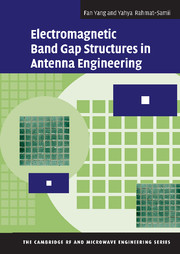Book contents
- Frontmatter
- Contents
- Preface
- Acknowledgements
- Abbreviations
- 1 Introduction
- 2 FDTD method for periodic structure analysis
- 3 EBG characterizations and classifications
- 4 Designs and optimizations of EBG structures
- 5 Patch antennas with EBG structures
- 6 Low profile wire antennas on EBG ground plane
- 7 Surface wave antennas
- Appendix: EBG literature review
- Index
- References
5 - Patch antennas with EBG structures
Published online by Cambridge University Press: 06 July 2010
- Frontmatter
- Contents
- Preface
- Acknowledgements
- Abbreviations
- 1 Introduction
- 2 FDTD method for periodic structure analysis
- 3 EBG characterizations and classifications
- 4 Designs and optimizations of EBG structures
- 5 Patch antennas with EBG structures
- 6 Low profile wire antennas on EBG ground plane
- 7 Surface wave antennas
- Appendix: EBG literature review
- Index
- References
Summary
Electromagnetic band gap structures have been characterized and designed in previous chapters. We now shift our focus to EBG applications in antenna engineering. In this chapter, the EBG structures are integrated into microstrip patch antenna designs and their surface wave band gap property helps to increase the antenna gain, minimize the back lobe, and reduce mutual coupling in array elements. Some applications of EBG patch antenna designs in high precision GPS receivers, wearable electronics, and phased array systems are highlighted at the end of the chapter.
Patch antennas on high permittivity substrate
Microstrip patch antennas are widely used in wireless communications due to the advantages of low profile, light weight, and low cost [1–2]. In principle, the microstrip patch antenna is a resonant type antenna, where the antenna size is determined by the operating wavelength and the bandwidth is determined by the Q factor of the resonance. An important research topic in microstrip antenna designs is to broaden the inherent narrow bandwidth of microstrip antennas. Parasitic patches are used to form a multi-resonant circuit so that the operating bandwidth is improved. In [3], the parasitic patches are located on the same layer with the main patch. In [4], a multi-layer microstrip antenna is investigated with parasitic patches stacked on the top of the main patch. The multi-resonant behavior can also be realized by incorporating slots into the metal patch. Several single-layer single-patch microstrip antennas have been reported, such as the U-slot microstrip antenna [5] and the E-shaped patch antenna [6].
- Type
- Chapter
- Information
- Electromagnetic Band Gap Structures in Antenna Engineering , pp. 127 - 155Publisher: Cambridge University PressPrint publication year: 2008

